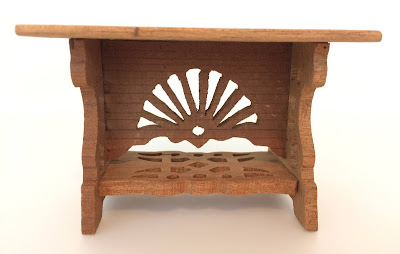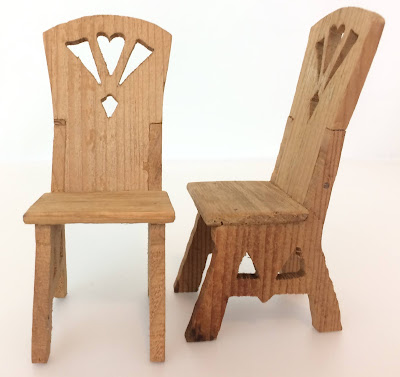I recently acquired this little fretwork kitchen.
I know nothing about the origin of these pieces,
but I do know the craftsmanship is superb.
I am unsure what type of wood was used to make this set, but as you will see later, more than one kind was used.
The table is a real work of beauty!
It is 1:12 scale: 2½" tall, 3¾" wide, 2¾" deep
The seller thought it might be Swedish.
I checked with Patricia, my US expert
on Swedish dollhouse furniture,
who checked with her Swedish expert in Sweden
who thought it might be German made.
Here you can see how neatly
the legs were joined to the back.
The small bench.
The stove is in the style of the 1920s, similar to the ones made
by Strombecker and Schoenhut during that period.
Along with the brass tacks used for knobs,
this style might help to date the years of production.
Unless, of course, these pieces are newly made
using vintage fretwork patterns.
The oven door opens.
Even the sides have fretwork....
....and fretwork "gas burners"!
The back, however, is plain.
With the hutch, you see evidence of different types of wood being used.
Doors and drawers open.
The doors on the top of the hutch have a mission style look
that was popular during the teens and 1920s.
The bottom of the hutch has a more ornate fretwork.
The back of the hutch, like the stove, is plain.
At the same time I acquired my fretwork kitchen set from Indiana,
a good friend found two hutches in Illinois.
One of her hutches is an exact duplicate of the one I have.
Here are her hutches.
So, what do you think? Vintage made during the 1920s, or newly made with vintage fretwork designs?
A little fretwork history from solarwoodcuts.com :
"The
art of fretwork began more than 3000 years ago with fretted inlays on furniture
in Egypt. It has been popular in North America and Europe from the mid
1800's until today. Fretwork of the 1800's and early 1900's was done with
hand fretsaws or foot-powered scroll saws. In the 1920's several scroll
saws were designed for use with electric motors."
More dollhouse furniture and patterns for fretwork dollhouse furniture can be seen here and here.
UPDATE 9/23/20:
After publishing this post on my fretwork kitchen, a lovely dining room set was discovered and my friend was able to add it to her collection! So, most likely, there are more pieces to discover!
Sue has added a light stain to her set....isn't it gorgeous!
The buffet and the hutch.....
.....and the complete set!
If you were wondering if the hutch
should sit on top of the buffet.....
....we decided the answer is NO!





















.jpg)





















































































